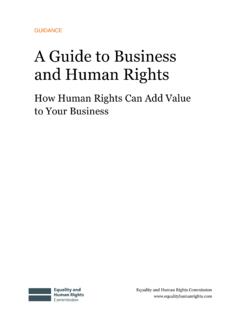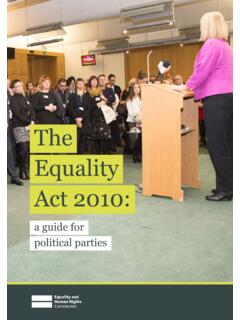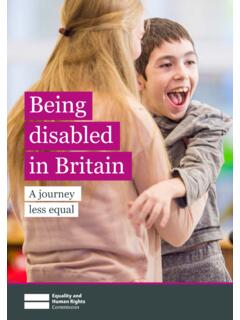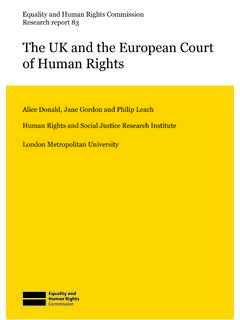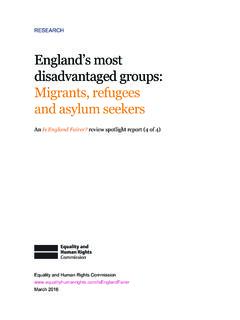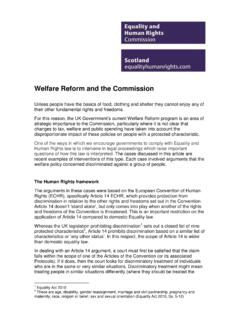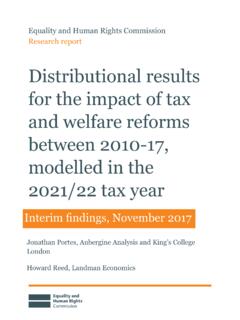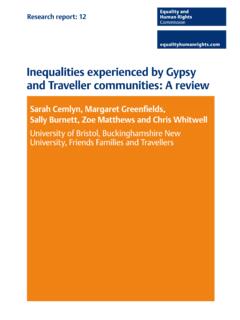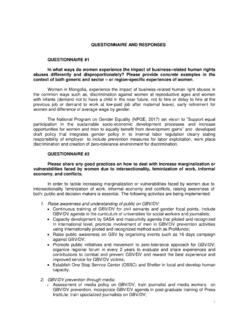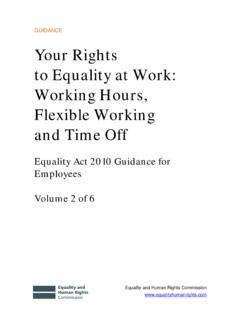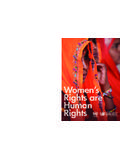Transcription of Services, public functions and associations Statutory Code ...
1 equality Act 2010 Code of Practice services , public functions and associations Statutory Code of Practice equality Act 2010 Code of Practice services , public functions and associations Statutory Code of Practice equality Act 2010 Statutory Code of Practice services , public functions and associations equality and human rights Commission (2011). The text of this document (this excludes, where present, the Royal Arms and all departmental and agency logos) may be reproduced free of charge in any format or medium providing that it is reproduced accurately and not in a misleading context. The material must be acknowledged as equality and human rights Commission copyright and the document title specified. Where third party material has been identified, permission from the respective copyright holder must be sought. Any enquiries regarding this publication should be sent to us at This publication is also available on ISBN: 9780108509728.
2 ID P002411441 01/11. Printed in the UK by The Stationery Office Limited on behalf of the Controller of Her Majesty's Stationery Office Printed on paper containing 75% recycled fibre content minimum. Contents 01. Contents 15 Foreword 17 Chapter 1: Introduction 17 Purpose of the equality Act 2010. 18 Status of the Code 18 Scope of the Code 19 Age as a protected characteristic 20 Marriage and Civil Partnership 20 Purpose of the Code 21 human rights 22 Large and small service providers 22 How to use the Code 23 Examples in the Code 24 Use of the terms service provider', services ' and service user'. 24 References in the Code 25 Changes to the law 26 Further information 27 Chapter 2: Who has rights under Part 3. ( services and public functions ) and Part 7. ( associations ) of the Act? 27 Introduction 28 Age 28 What the Act says 28 Disability 28 What the Act says 30 Gender reassignment 30 What the Act says 02 Contents 32 Gender Recognition Certificates 32 Pregnancy and maternity 32 What the Act says 33 Race 33 What the Act says 33 Nationality 33 Ethnic Origins 34 National Origins 34 Meaning of Racial Group'.
3 35 Religion or belief 35 What the Act says 35 Meaning of religion 36 Meaning of belief 37 Manifestation of religion or beliefs 37 Sex 37 What the Act says 38 Sexual orientation 38 What the Act says 39 Restrictions on protection under the Act 40 Chapter 3: Who has obligations under Part 3. ( services and public functions ) and Part 7. ( associations ) of the Act? 40 Introduction 41 services to the public 41 public functions 42 associations 42 Relationships which have ended 43 Contracts 43 Unenforceable terms 44 Removal or modification of terms 44 Territorial scope 45 What is not covered by the Code? 45 Education 03. 45 Premises 46 Transport 46 Ships and hovercrafts 46 Employment services 47 Exceptions 47 Liability of employers and principals 47 What the Act says 47 When is an act in the course of employment'. or with the authority of a principal'?
4 48 The employer's defence 49 Liability of employees and agents 49 What the Act says 49 Knowledge that the act is unlawful 49 Meeting obligations under the Act: avoiding discrimination and good practice 52 Chapter 4: Direct discrimination 52 Introduction 52 What the Act says 53 What is less favourable' treatment? 54 Segregation 55 Shared protected characteristics 55 Because of' a protected characteristic 58 Discrimination by association 59 Discrimination by perception 60 Comparators 60 Who will be an appropriate comparator? 61 Hypothetical comparators 63 Comparators in disability cases 63 Comparators in sexual orientation cases 64 Advertising an intention to discriminate 64 When is it lawful to treat a person more favourably? 64 More favourable treatment of disabled people 04 Contents 64 Discrimination because of pregnancy and maternity 65 What does unfavourable mean?
5 66 What does because of' mean in relation to pregnancy and maternity? 67 Direct sex discrimination: pregnancy and maternity 68 Exceptions for pregnancy and maternity 69 Chapter 5: Indirect Discrimination 69 Introduction 69 What does the Act say? 70 What constitutes a provision, criterion or practice? 70 Is the provision, criterion or practice a neutral one? 71 What does would put' mean? 72 What is a disadvantage? 74 The comparative approach 74 The pool for comparison'. 75 Making the comparison 75 Carrying out a formal comparative exercise 77 Is the service user concerned put at that disadvantage? 77 The intention behind the provision criterion or practice is irrelevant 78 When can a provision, criterion or practice be objectively justified? 79 What is a legitimate aim? 79 What is proportionate? 81 public authorities and justification of indirect discrimination 81 Indirect discrimination and the duty to make reasonable adjustments for disabled persons 83 Chapter 6: Discrimination arising from disability 83 Introduction 84 What is discrimination arising from disability?
6 05. 84 What does the Act say? 84 How does it differ from direct discrimination? 81 How does it differ from indirect discrimination? 85 Is a comparator required? 86 What is unfavourable treatment? 86 What does something arising in consequence of disability' mean? 87 When can discrimination arising from disability be justified? 87 What if the service provider does not know that the person is disabled? 89 Can service providers treat a disabled person more favourably? 89 Relevance of reasonable adjustments 90 Chapter 7: Disabled persons: reasonable adjustments 90 Introduction 91 What is the duty to make reasonable adjustments? 92 Accessible information 92 What disadvantage gives rise to the duty? 93 Are there any limits on the duty to make reasonable adjustments? 94 To whom is the duty to make reasonable adjustments owed? 94 An anticipatory duty: the point at which the duty to make reasonable adjustments arises 95 Does the duty to make reasonable adjustments apply even if the service provider does not know that the person is disabled?
7 95 Must service providers anticipate every barrier? 96 How long does the duty continue? 97 What is meant by reasonable' steps? 100 Costs of providing reasonable adjustments 06 Contents 101 What happens if the duty to make reasonable adjustments is not complied with? 101 What is the duty to change a provision criterion or practice? 101 What is a provision criterion or practice? 102 Provision of information 102 What is the duty to provide auxiliary aids or services ? 103 What is an auxiliary aid or service? 103 Provision of information 104 Physical features 104 What is the duty to make reasonable adjustments to physical features? 104 Avoiding substantial disadvantage 105 Removing the physical feature 105 Altering the physical feature 105 Providing a reasonable means of avoiding the physical feature 106 Providing a reasonable alternative method of making services available 107 What is a physical feature'?
8 109 Leases, binding obligations and reasonable adjustments 109 What happens if a binding obligation other than a lease prevents a building being altered? 109 What happens if a lease says that certain changes to premises cannot be made? 111 What about the need to obtain Statutory consent for some building changes? 111 Special provisions regarding transport vehicles 112 Reasonable Adjustments in Practice 113 Chapter 8: Harassment 113 Introduction 113 What does the Act say? 07. 114 Harassment related to a protected characteristic 115 Related to'. 115 a) Where the conduct is related to the service user's own protected characteristic. 116 b) Where there is any connection with a protected characteristic. 118 Sexual harassment 118 Less favourable treatment for rejecting or submitting to unwanted conduct 119 Purpose or effect'. 121 Statutory defence 121 Liability of employers and principals 122 Chapter 9: Victimisation and other unlawful acts 122 Introduction 122 Victimisation 122 What the Act says 123 What is a protected act'?
9 124 What is a detriment'? 125 What other factors are involved in proving that victimisation has occurred? 126 Instructing, causing or inducing discrimination 126 What the Act says 128 When does the Act apply? 128 Who is protected? 129 Aiding contraventions 129 What the Act says 130 What does it mean to help someone commit an unlawful act? 130 What does the helper need to know to be liable? 130 Reasonable reliance on another's statement 08 Contents 132 Chapter 10: Positive Action 132 Introduction 132 What is positive action? 133 Distinguishing positive action and positive discrimination'. 135 Voluntary nature of positive action 135 What the Act says 137 What does reasonably think' mean? 138 Action to remedy disadvantage 138 What is a disadvantage for these purposes? 138 What action might be taken to enable or encourage people to overcome or minimise the disadvantage?
10 139 Action to meet needs 139 What are different' or particular' needs? 139 What action might be taken to meet those needs? 140 Action to encourage participation in activities 140 What activities does this apply to? 140 What does disproportionately low' mean? 141 What action should be taken? 142 What does proportionate' mean? 143 Time-limited positive action 144 Positive action and disability 144 Positive action and the public sector equality duties 144 Political parties and positive action 145 Implementing positive action lawfully 146 Chapter 11: services and public functions 146 Introduction 146 What does discrimination mean in this chapter? 147 services 147 What is a service'? 148 services provided to the public by more than one provider 148 Website services 09. 150 public functions 150 What is a public function? 151 Interaction with the services provisions 152 What is unlawful discrimination in relation to services ?
